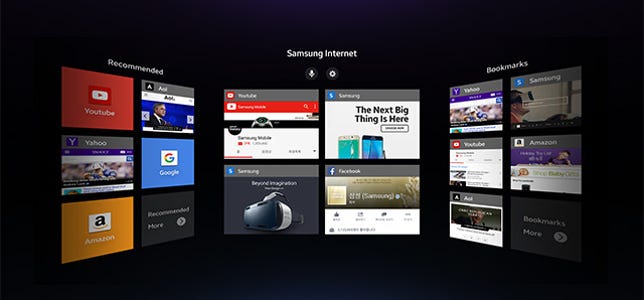Samsung is kicking off a new phase of its plans for virtual-reality tech with the release of a dedicated Web browser for its Gear VR headset.
Samsung Internet for Gear VR is an app that lets people browse the Web in a panoramic environment and immerse themselves in the Internet without actually downloading content to their phones. The app, set for release Wednesday, can play any HTML5 video file on the Web and also supports 360-degree and 3D video streaming.
Virtual reality is a fast-growing medium that relies on people wearing headsets like the Gear VR and rival devices from Google, HTC, Sony and others to visually place themselves in another world, often as part of a game. Partnering with Facebook-owned Oculus, which is working on its own virtual-reality headset, Samsung created its Gear VR, one of the first such devices to come to market.

 Enlarge Image
Enlarge ImageSamsung hopes that expanding VR content will help its virtual-reality headset succeed in the market.
Samsung
VR will be a dud, though, if there’s nothing to do with it. The big opportunities are games and videos, but browser technology could quickly give VR headset owners a lot more to explore.
More than a year after first showing off its headset, Samsung started selling Gear VR in the US in November and released it in the UK on Wednesday. The South Korean company’s next step is to ensure that content is accessible, easy to use and original enough that people will invest in its hardware before competing devices go on sale.
“As the demand for 360-degree, immersive video content rapidly rises, Samsung Internet for Gear VR further enriches the VR content ecosystem for our consumers, setting an industry standard for the VR viewing experience,” Chan-Woo Park, Samsung’s vice president of product strategy, information technology and mobile, said in a statement.
Internet for Gear VR focuses on finding content, not just displaying it. The app supports voice recognition and Gaze Mode, which enables people to navigate through menus by looking directly at items to select them. Should you wish to replicate your normal browsing experience in VR, it’s possible to import bookmarks from Samsung Internet for Android. Other mobile browsers aren’t compatible for bookmark import, though.
Samsung isn’t alone in trying to bring the Web to VR. It presented its VR browser chiefly as two-dimensional panes hovering in space. But VR on the Web could get even more interesting if a Mozilla-led project called WebVR catches on. With that technology, programmers could build VR-tailored websites like virtual product tours, games and maps. And if WebVR-equipped browsers catch on (so far there are only WebVR prototypes of Mozilla’s Firefox and Google’s Chrome), then programmers could have an easier time bringing their virtual wares to multiple VR headsets.
The beta version of the Internet for Gear VR app is set to show up in the Oculus Store later Wednesday. The app is compatible with all the phones that can be used inside the Gear VR: the Galaxy S6, Galaxy S6 Edge, Galaxy S6 Edge+, Galaxy Note 4 and Galaxy Note 5.



